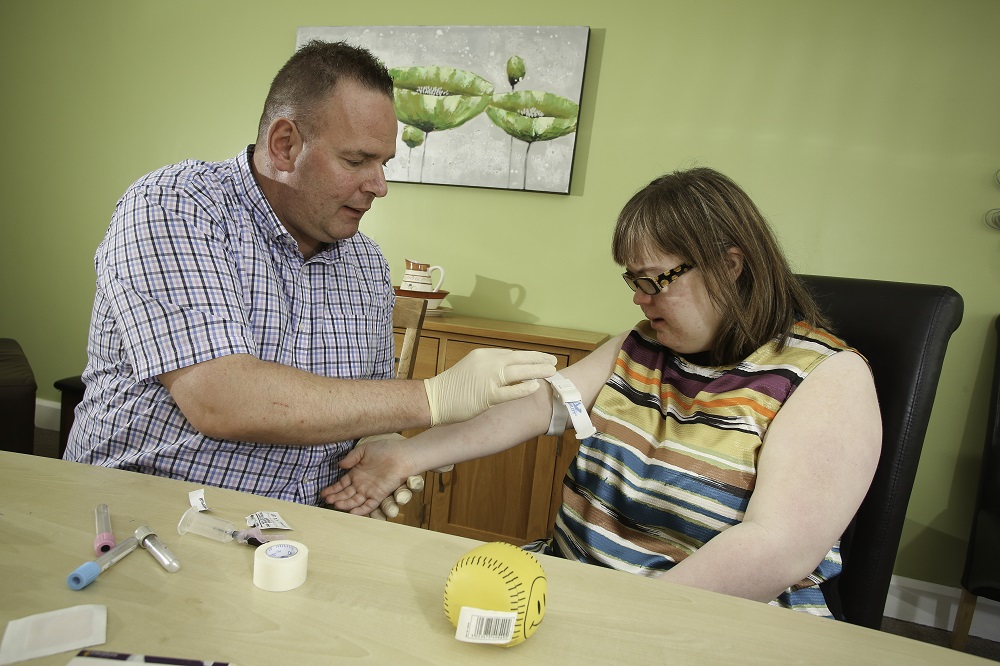Understanding a person’s likes and dislikes is key to reducing anxiety when taking blood, according to Cemlyn Roberts, winner of the RCN Healthcare Assistant Award 2017.
Cemlyn is based in Ruthin in north Wales, where he works in the community as a health liaison health care support worker. He provides vital support to people with learning disabilities who may be worried about the process of having blood taken.
“A lot of people with learning disabilities can be quite scared about having their blood taken – they may have had a bad experience in the past or it’s too unfamiliar,” explains Cemlyn. “Our desensitisation programme gets them used to the process until it becomes a safe thing. We take it one step at a time.”

Shaping the service
Cemlyn joined the community liaison health team in 2010, when the HCSW role was in its infancy, and helped shape the eight-week programme into what it is today.
“Lots of people were not having their blood tests but it’s a powerful and important test to have, giving crucial information about a person’s health. It’s even more important when someone might struggle to communicate when something’s wrong.”
 Cemlyn collects his award from Chair of RCN Council Michael Brown and TV presenter Kate Garraway. Picture by Barney Newman
Cemlyn collects his award from Chair of RCN Council Michael Brown and TV presenter Kate Garraway. Picture by Barney Newman
Cemlyn now carries out the majority of blood desensitisation referrals to the team. He says there are a number of ways to help ease people’s fears.
“It’s important to clearly explain why a blood test is necessary and what it entails. We use flashcards with easy-read information, as well as role play. A sense of humour often comes in handy too,” he adds.
We put One Direction on while the needle was going in
“One of the most effective ways is to get to know the person as an individual. You’ve got to be imaginative and try to make it a positive experience, perhaps with things they like to watch or listen to.
“Recently one lady liked One Direction so we put them on the iPad while the needle was going in. Another time we had Fawlty Towers running. Chocolate eclairs have also worked wonders as a treat before or after the procedure. Distraction can be a very effective method as long as it’s specific to the person.”
Tailoring techniques
The tailored techniques Cemlyn uses have had a 98% success rate, resulting in a drop in the use of sedation. Not only that, but after completing the programme, people are usually a lot less anxious about future blood tests.
So what does the future hold? As well as plans to publish his blood desensitisation work, Cemyln hopes to expand another area of his work – a health promotion programme he has produced for men with learning disabilities. “I love my job and want to continue supporting the community to have better, healthier lives,” he says. “It’s empowering to know I'm helping people."
Cemlyn's tips for taking blood
- Make sure the person has someone they know and trust on duty.
- Easily accessible clothes such as a short sleeved blouse or shirt and a cardigan are best.
- Stress balls or spongey items can be used to squeeze while waiting to help palpitate the veins.
- Use distraction techniques such as the cough trick – ask the person to look away and cough while you stick the needle in. If they can’t cough, try simple visual or verbal distraction across the other side of the room.
- Consider using coping strategies such as deep breathing.
Find out more
Join the RCN Learning Disability Nursing Forum to influence national policy and practice and champion the rights and choices of people with learning disabilities.








